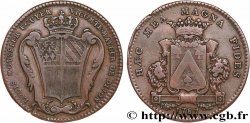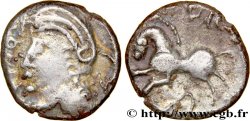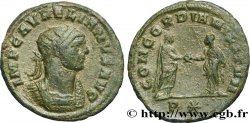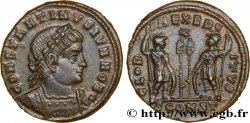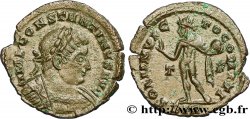fjt_059600 - DIJON (MAIRES DE ... et divers) Pierre Canquoin, prévôt de la Monnaie de Dijon 1593
380.00 €
Menge
In den Warenkorb

Type : Pierre Canquoin, prévôt de la Monnaie de Dijon
Datum: 1593
Metall : Kupfer
Durchmesser : 28,5 mm
Stempelstellung : 6 h.
Gewicht : 4,31 g.
Rand lisse
Seltenheitsgrad : R3
Kommentare zum Erhaltungszustand:
Belle patine vert sombre. Flan légèrement voilé et quelques petits coups sur la tranche mais document très intéressant
N° im Nachschlagewerk :
Vorderseite
Titulatur der Vorderseite +. PIERRE. CANQVOIN. PREVOST. DE. LA..
Beschreibung Vorderseite Au milieu d’un cartouche fleuronné dans une couronne de laurier : MONNOIE/ DE DIION/ 1593.
Rückseite
Titulatur der Rückseite +. LABORARE * ET * LETARI (FLEURS).
Beschreibung Rückseite Écu armorié entre deux tiges de rosier fleuries portant deux étoiles, un coin de droit et de revers ainsi qu’un marteau.
Übersetzung der Rückseite (Travailler d’abord, se reposer ensuite).
Kommentare
Pierre Canquoin, prévôt de la Monnaie de Dijon fut chargé de l’analyse des pièces que les Politiques faisaient forger à Saint-Jean-de-Losne. Au revers de son jeton, on remarque en manière d’armoiries, six pièces de monnaie, des coins, un marteau et une fleur qui s’épanouit au centre. Rappelons que la ville de Dijon refusa de reconnaître Henri IV et que la Monnaie de Dijon fabriqua au nom de Charles X jusqu’en 1595, date à laquelle la ville se soumet à Henri IV. Celui-ci, pour concurrencer cette ville ligueuse avait ouvert un atelier à Saint-Jean-de-Losne (puis à Semur) avec les mêmes différents que ceux de l’atelier de Dijon.
Pierre Canquoin, provost of the Dijon Mint, was responsible for analyzing the coins that the Politicians had forged in Saint-Jean-de-Losne. On the reverse of his token, we notice, in the manner of a coat of arms, six coins, dies, a hammer and a flower blooming in the center. Let us recall that the city of Dijon refused to recognize Henry IV and that the Dijon Mint manufactured in the name of Charles X until 1595, when the city submitted to Henry IV. The latter, to compete with this League city, had opened a workshop in Saint-Jean-de-Losne (then in Semur) with the same differences as those of the Dijon workshop.
Pierre Canquoin, provost of the Dijon Mint, was responsible for analyzing the coins that the Politicians had forged in Saint-Jean-de-Losne. On the reverse of his token, we notice, in the manner of a coat of arms, six coins, dies, a hammer and a flower blooming in the center. Let us recall that the city of Dijon refused to recognize Henry IV and that the Dijon Mint manufactured in the name of Charles X until 1595, when the city submitted to Henry IV. The latter, to compete with this League city, had opened a workshop in Saint-Jean-de-Losne (then in Semur) with the same differences as those of the Dijon workshop.








 Berichten über einen Fehler
Berichten über einen Fehler Die Seite drucken
Die Seite drucken Teilen meiner Auswahl
Teilen meiner Auswahl Stellen Sie eine Frage
Stellen Sie eine Frage Einlieferung/Verkauf
Einlieferung/Verkauf
 Details
Details


